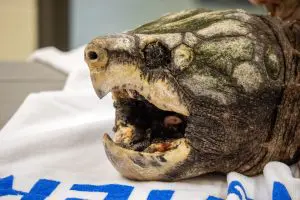

Capone is one special turtle.
If you’ve visited the Zoo, you’ve likely met a lot of our more than 900 animal residents. Some animals are easy to spot, but others are often not as easy to see because of their habitat set up, their personalities or their sleep cycles among other things. We wanted to start a “Meet the Animals” section of our blog to introduce you to some of the residents that you may (or may not have) met yet!
We have many very spe-shell reptile residents who call our Zoo home, but few have been around as long as Capone. Capone, who has been a member of the Zoo for about 15 years, is our 57-year-old alligator snapping turtle whose habitat is tucked to the side near our alligators and crested caracara in the Wild Florida loop. While his habitat can be easy to walk past, he seems to have garnered a bit of a fan base amongst Zoo visitors.
If you’ve wandered by to visit this big guy, you’ve likely seen Capone peacefully swimming among the edges of his habitat, or luring with his mouth open, a natural behavior where he will sit completely still with his mouth wide open and wiggle his worm-like tongue to attract prey. Being an alligator snapping turtle, Capone very rarely will exit the water. The species can hold their breath for up to 50 minutes, which assists them in their natural aquatic state. This species also has incredibly strong jaws made to crush bones, including one of their favorite foods — smaller species of turtle.
One of the most obvious ways Capone can attract a crowd is his unmissable presence and prehistoric-looking features. From his fleshy, pointy eyelashes to his thick dinosaur-like tail, this reptile is easy to stare at for a long while. But it’s not just his handsome features that makes Capone a must-see stop on your tour of the Zoo. He is also known for his curious nature with guests.
“He is very interactive—he loves to follow kids along the window and will even swim away from a training session to do so,” noted Nicole Payne, Area Supervisor of Herps & Aquatics.
While Capone is a fan favorite among guests, and the internet as a whole, he’s also beloved by his keepers.

Can you spot his worm-like tongue?
When Capone is not napping in unseen corners in his habitat or luring with his mouth, he can be actively participating in a training session with keepers. He is very interested in training and has always risen to the occasion when presented with a new training challenge. Targeting, for instance, is a great way to have him go toward keepers, so they can check on him. He is also trained to place his head inside of a bucket with the bottom cut out, which is called a “head shield.” It enables his animal care team to keep their hands safe when working closely with him for medical needs or otherwise.
“For an animal that naturally lives a cryptic lifestyle, he very quickly showed that he was very interested in training,” said Nicole.
During his down time, Capone enjoys engaging with his enrichment items. Some of his favorites include puzzle feeders, knocking food out of heavy-duty balls, hiding in new palms or felt strips, and rolling around with a good log.
“Capone is such an interactive animal who is capable of so much more than anyone used to give this species credit for,” said Nicole. “He’s so smart, so engaging, and so silly. I just adore working with him.”
Brevard Zoo is an independent, not-for-profit organization that receives no recurring government funding for our operating costs. Your generous support enables us to continue to serve our community and continue our vital animal wellness, education and conservation programs.